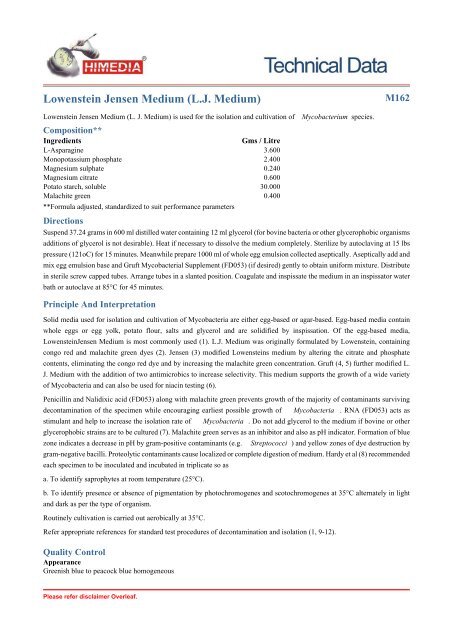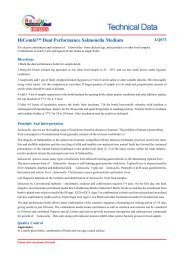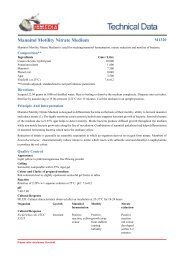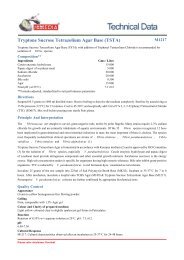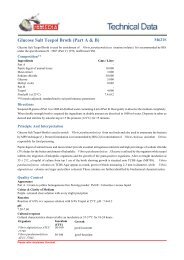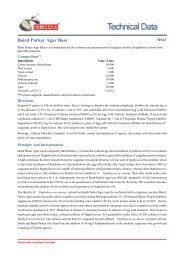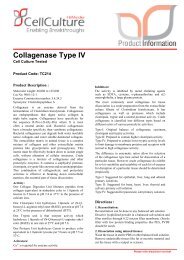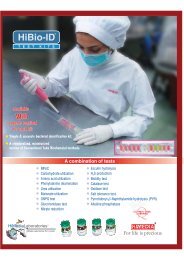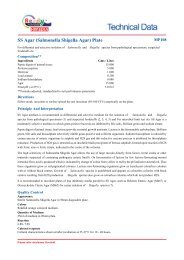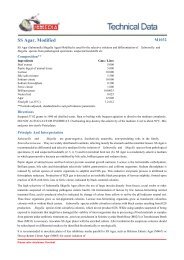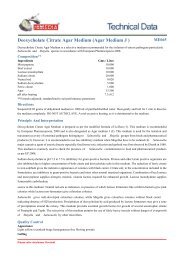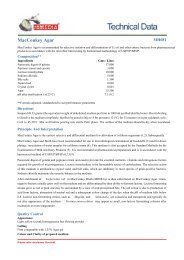Lowenstein Jensen Medium (L.J. Medium) - Himedia Laboratories
Lowenstein Jensen Medium (L.J. Medium) - Himedia Laboratories
Lowenstein Jensen Medium (L.J. Medium) - Himedia Laboratories
You also want an ePaper? Increase the reach of your titles
YUMPU automatically turns print PDFs into web optimized ePapers that Google loves.
<strong>Lowenstein</strong> <strong>Jensen</strong> <strong>Medium</strong> (L.J. <strong>Medium</strong>)<br />
<strong>Lowenstein</strong> <strong>Jensen</strong> <strong>Medium</strong> (L. J. <strong>Medium</strong>) is used for the isolation and cultivation of Mycobacterium species.<br />
Composition**<br />
Ingredients Gms / Litre<br />
L-Asparagine 3.600<br />
Monopotassium phosphate 2.400<br />
Magnesium sulphate 0.240<br />
Magnesium citrate 0.600<br />
Potato starch, soluble 30.000<br />
Malachite green 0.400<br />
**Formula adjusted, standardized to suit performance parameters<br />
Please refer disclaimer Overleaf.<br />
M162<br />
Directions<br />
Suspend 37.24 grams in 600 ml distilled water containing 12 ml glycerol (for bovine bacteria or other glycerophobic organisms<br />
additions of glycerol is not desirable). Heat if necessary to dissolve the medium completely. Sterilize by autoclaving at 15 lbs<br />
pressure (121oC) for 15 minutes. Meanwhile prepare 1000 ml of whole egg emulsion collected aseptically. Aseptically add and<br />
mix egg emulsion base and Gruft Mycobacterial Supplement (FD053) (if desired) gently to obtain uniform mixture. Distribute<br />
in sterile screw capped tubes. Arrange tubes in a slanted position. Coagulate and inspissate the medium in an inspissator water<br />
bath or autoclave at 85°C for 45 minutes.<br />
Principle And Interpretation<br />
Solid media used for isolation and cultivation of Mycobacteria are either egg-based or agar-based. Egg-based media contain<br />
whole eggs or egg yolk, potato flour, salts and glycerol and are solidified by inspissation. Of the egg-based media,<br />
<strong>Lowenstein</strong><strong>Jensen</strong> <strong>Medium</strong> is most commonly used (1). L.J. <strong>Medium</strong> was originally formulated by <strong>Lowenstein</strong>, containing<br />
congo red and malachite green dyes (2). <strong>Jensen</strong> (3) modified <strong>Lowenstein</strong>s medium by altering the citrate and phosphate<br />
contents, eliminating the congo red dye and by increasing the malachite green concentration. Gruft (4, 5) further modified L.<br />
J. <strong>Medium</strong> with the addition of two antimicrobics to increase selectivity. This medium supports the growth of a wide variety<br />
of Mycobacteria and can also be used for niacin testing (6).<br />
Penicillin and Nalidixic acid (FD053) along with malachite green prevents growth of the majority of contaminants surviving<br />
decontamination of the specimen while encouraging earliest possible growth of Mycobacteria . RNA (FD053) acts as<br />
stimulant and help to increase the isolation rate of Mycobacteria . Do not add glycerol to the medium if bovine or other<br />
glycerophobic strains are to be cultured (7). Malachite green serves as an inhibitor and also as pH indicator. Formation of blue<br />
zone indicates a decrease in pH by gram-positive contaminants (e.g. Streptococci ) and yellow zones of dye destruction by<br />
gram-negative bacilli. Proteolytic contaminants cause localized or complete digestion of medium. Hardy et al (8) recommended<br />
each specimen to be inoculated and incubated in triplicate so as<br />
a. To identify saprophytes at room temperature (25°C).<br />
b. To identify presence or absence of pigmentation by photochromogenes and scotochromogenes at 35°C alternately in light<br />
and dark as per the type of organism.<br />
Routinely cultivation is carried out aerobically at 35°C.<br />
Refer appropriate references for standard test procedures of decontamination and isolation (1, 9-12).<br />
Quality Control<br />
Appearance<br />
Greenish blue to peacock blue homogeneous
HiMedia <strong>Laboratories</strong> Technical Data<br />
Gelling<br />
free flowing powder<br />
Colour and Clarity of prepared medium<br />
The mixture of sterile basal medium and whole egg emulsion, when inspissated, coagulates to yield pale bluish green<br />
coloured, opaque smooth slants<br />
Cultural Response<br />
M162: Cultural characteristics observed in presence of 5-10% Carbon dioxide, with added egg emulsion base, after an incubation at<br />
35-37ºC for 2-4 weeks.<br />
Organism<br />
Cultural Response<br />
Growth Growth<br />
with Gruft<br />
Supplement<br />
(FD053)<br />
Mycobacterium avium ATCC<br />
25291<br />
Please refer disclaimer Overleaf.<br />
Colony<br />
Characteristic<br />
luxuriant good-luxuriant smooth, nonpigmented<br />
Mycobacterium gordonae luxuriant<br />
colonies<br />
good-luxuriant smooth, yellow,<br />
ATCC 14470<br />
orange colonies<br />
Mycobacterium kansasii luxuriant good-luxuriant photochromogenic,<br />
ATCC 12478<br />
smooth to<br />
rough<br />
Mycobacterium smegmatis luxuriant good-luxuriant wrinkled,creamy<br />
ATCC 14468<br />
white colonies<br />
M. tuberculosis H37RV luxuriant good-luxuriant granular, rough,<br />
ATCC 25618<br />
warty, dry<br />
friable colonies<br />
Storage and Shelf Life<br />
Store below 30°C in tightly closed container and prepared medium at 2-8°C. Use before expiry period on the label.<br />
Reference<br />
1. Murray P. R., Baron E. J., Jorgensen J. H., Pfaller M. A., Yolken R. H., (Eds.), 8th Ed., 2003, Manual of Clinical<br />
Microbiology, ASM, Washington, D.C.<br />
2. <strong>Lowenstein</strong> E., 1931, Zentralbl. Bakteriol. Parasitenkd. Infektionskr. Hyg. Abt. 1 Orig., 120:127.<br />
3. <strong>Jensen</strong> K. A., 1932, Zentralb. Bakteriol. Parasitenkd. Infektionskr. Hyg. Abt. I Orig., 125:222.<br />
4. Gruft, 1971, Health Lab. Sci., 8:79.<br />
5. Gruft, 1963, Am. Rev. Respir. Dis., 88:412.<br />
6. Boisvert H., 1960, Ann. Inst. Pasteur, 99:600.<br />
7. MacFaddin J. F., 1985, Media for Isolation-Cultivation-Identification-Maintenance of Medical Bacteria, Vol. 1, Williams<br />
and Wilkins, Baltimore.<br />
8. Boisvert H., 1960, Ann. Inst. Pasteur, 99:600.<br />
Kent P. T and Kubica G. P., 1985, Public Health Mycobacteriology: A Guide to the level III Laboratory, USDHHS, Centers<br />
for Disease Control, Atlanta, Ga.<br />
9. Forbes B. A., Sahm A. S. and Weissfeld D. F., Bailey & Scotts Diagnostic Microbiology, 10th Ed., 1998, Mosby, Inc., St.<br />
Louis, Mo.<br />
10. Cernoch P., Enns R., Saubolle M. and Wallace R., 1994, Cumitech, 16A, Laboratory Diagnosis of the Mycobacterioses<br />
coord , Ed., Weissfeld , ASM, Washington, D. C.<br />
11.Isenberg, (Ed.), 1992, Clinical Microbiology Procedures Handbook, Vol. I, ASM, Washington, D. C.<br />
Revision : 1 / 2011
HiMedia <strong>Laboratories</strong> Technical Data<br />
Disclaimer :<br />
User must ensure suitability of the product(s) in their application prior to use. Products conform solely to the information contained in this<br />
and other related HiMedia publications. The information contained in this publication is based on our research and development work<br />
and is to the best of our knowledge true and accurate. HiMedia <strong>Laboratories</strong> Pvt Ltd reserves the right to make changes to specifications<br />
and information related to the products at any time. Products are not intended for human or animal diagnostic or therapeutic use but for<br />
laboratory, research or further manufacturing use only, unless otherwise specified. Statements contained herein should not be considered<br />
as a warranty of any kind, expressed or implied, and no liability is accepted for infringement of any patents.<br />
HiMedia <strong>Laboratories</strong> Pvt. Ltd. A-516,Swastik Disha Business Park,Via Vadhani Ind. Est., LBS Marg, Mumbai-400086, India. Customer care No.: 022-6147<br />
1919 Email: techhelp@himedialabs.com


